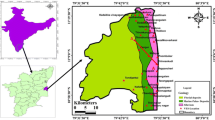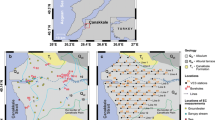Abstract
Seawater intrusions are a major environmental hazard for coastal freshwater aquifers. They are generated mainly by the uncontrolled exploitation of freshwater in pumping stations, if the aquifers are in hydraulic connection with the sea. In Romania, such marine intrusions have occurred in the southern part of Black Sea’s coastline, in Costinești and Vama Veche resorts, contaminating the main aquifers hosted in Sarmatian (late Middle Miocene) limestones, at distances ranging from hundreds of meters to over 2 km inland. For the study of these salinization phenomena, Vertical Electrical Sounding (VES) surveys were performed in the affected areas. These surveys allowed the delineation and spatial–temporal monitoring of the intrusions and offered information related to faults that may have provided pathways for seawater migration toward the exploitation wells. The 1D interpretation of VES apparent resistivity data was performed via a set of novel software applications. The forward modeling component of the applications uses digital linear filtering and allows the simulation of theoretical VES responses for horizontally-layered geological media with virtually unlimited number of layers. The pseudo-inversion component of the applications is based on a random sampling of the parameters space of the geoelectrical models. The interpretation of VES surveys recorded in Vama Veche area by using the elaborated software indicates that the seawater intrusion occurs at more than 40 m depth. This agrees with a well flow test which produced saltwater at 40–60 m depth in that area.
















Similar content being viewed by others
References
Binley A, Kemna A (2005) DC resistivity and induced polarization methods. In: Rubin Y, Hubbard SS (eds) Hydrogeophysics. Springer, Dordrecht, pp 129–156
Cazacu GB (2015) Dobrogea geology. In: Maftei C (ed) Extreme weather and impacts of climate change on water resources in the Dobrogea region. IGI Global, Pennsylvania, pp 73–118
Conea A (1970) Quaternary formations in Dobrogea (loess and paleo soils). Publishing House of the Romanian Academy, Bucharest (in Romanian)
Das UC, Ghosh DP (1974) The determination of filter coefficients for the computation of standard curves for dipole resistivity sounding over layered earth by linear digital filtering. Geophys Prospect 2(4):765–780
Georgescu P, Dinu C, Niculescu V, Ion D (1993) Some applications of VES to groundwater exploration in the vicinity of the Romanian coast of the Black Sea. Rev Roum Géophys 37:113–121
Georgescu P, Ioane D, Niculescu BM, Chitea F (2009) Long-time Geoelectrical modeling of groundwater contamination—case studies from Romania. In: Near surface 2009—15th European meeting of environmental and engineering geophysics, Dublin, Ireland, Extended Abstracts, paper P10, https://doi.org/10.3997/2214-4609.20147082
Georgescu P, Ioane D, Niculescu BM, Chitea F (2010) Geoelectrical investigations of marine intrusions on the Romanian Black Sea Shore. GeoEcoMarina 16:95–102
Ghosh DP (1971) The application of linear filter theory to the direct interpretation of geoelectrical resistivity sounding measurements. Geophys Prospect 19:192–217
Goldman M, Kafri U (2006) Hydrogeophysical applications in coastal aquifers. In: Vereecken H, Binley A, Cassiani G, Revil A, Titov K (eds) Applied hydrogeophysics. Springer, Dordrecht, pp 233–254
Goldman M, Gilad D, Ronen A, Melloul A (1991) Mapping of seawater intrusion into the coastal aquifer of Israel by the time domain electromagnetic method. Geoexploration 28:153–174
Goldman M, Gvirtzman H, Meju M, Shtivelman V (2005) Hydrogeophysical case studies at the regional scale. In: Rubin Y, Hubbard SS (eds) Hydrogeophysics. Springer, Dordrecht, pp 361–389
Guptasarma D (1982) Optimization of short digital linear filters for increased accuracy. Geophys Prospect 30:501–514
Kobr M, Mareš S, Paillet F (2005) Borehole geophysics for hydrogeological studies: principles and applications. In: Rubin Y, Hubbard SS (eds) Hydrogeophysics. Springer, Dordrecht, pp 291–331
Koefoed O (1970) A fast method for determining the layer distribution from the raised kernel function in geoelectrical soundings. Geophys Prospect 18:564–570
Liteanu E, Ghenea C (1966) Quaternary from Romania. Technical and Economic Studies, Series H, Nr. 1, Comitetul Geologic, Bucharest, Romania (in Romanian)
Moroșanu I (2007) Romanian continental plateau of the Black Sea: tectonic-sedimentary evolution and hydrocarbon potential. Oscar Print Publishing House, Bucharest
Mościcki WJ (2011) The use of the DC resistivity sounding in high mountain areas—example from periglacial zone of the Sucha Woda Valley (Tatra Mts., Poland). Studia Geomorphologica Carpatho-Balcanica XLV:107–120, ISSN 0081-6434
Mutihac V, Stratulat IM, Fechet RM (2004) Geology of Romania. Didactic and Pedagogic Publishing House, Bucharest (in Romanian)
O’Neill DJ (1975) Improved linear coefficients for application in apparent resistivity computations. Bull Aust Soc Explor Geophys 6(4):104–109
Paillet FL (2002) Spatial scale analysis in geophysics—integrating surface and borehole geophysics in groundwater studies. In: Singhroy VF, Hansen DT, Pierce RR, Johnson AIIA (eds) Spatial methods for solution of environmental and hydrologic problems—science, policy, and standardization. ASTM International Special Technical Publication, West Conshohocken, pp 77–91
Paillet FL, Hite L, Carlson M (1999) Integrating surface and borehole geophysics in ground water studies—an example using electromagnetic soundings in south Florida. J Environ Eng Geophys 4(1):45–55
Paine JG, Minty BRS (2005) Airborne hydrogeophysics. In: Rubin Y, Hubbard SS (eds) Hydrogeophysics. Springer, Dordrecht, pp 333–357
Parasnis DS (1986) Principles of applied geophysics, 4th edn. Chapman and Hall, New York
Săndulescu M (1984) Geotectonics of Romania. Technical Publishing House, Bucharest (in Romanian)
Sheriff SD (1992a) Spreadsheet modeling of electrical sounding experiments. Ground Water 30(6):971–974
Sheriff SD (1992b) Forward modeling of electrical sounding experiments using convolution and a spreadsheet. Comput Geosci 18(1):75–78
Telford WM, Geldart LP, Sheriff RE (1990) Applied geophysics, 2nd edn. Cambridge University Press, Cambridge
Țenu A, Davidescu F, Echinger L, Voerkelius S (1997) Quality evaluation of groundwaters in Southern Dobrogea. Theor Appl Karstol 10:63–77
Visarion M, Săndulescu M, Roșca V, Stănică D, Atanasiu L (1990) La Dobrogea dans le cadre de l’avant pays Carpatique. Rev Roum Géophys 34:55–65
Werner AD, Bakker M, Post VEA, Vandenbohede A, Lu C, Ataie-Ashtiani B, Simmons CT, Barry DA (2013) Seawater intrusion processes, investigation and management: recent advances and future challenges. Adv Water Resour 51:3–26
Yang C-H, Tong L-T, Huang C-F (1999) Combined application of DC and TEM to sea-water intrusion mapping. Geophysics 64:417–425
Zohdy AAR (1989) A new method for the automatic interpretation of Schlumberger and Wenner sounding curves. Geophysics 54(2):245–253
Acknowledgements
Part of the geoelectrical data used in this study were recorded in field campaigns financed by the Romanian National University Research Council (CNCSIS), project PNII-IDEI 992/2009-2010. The authors would like to express their gratitude to the reviewers who carefully analyzed the manuscript and provided valuable comments and suggestions.
Author information
Authors and Affiliations
Corresponding author
Ethics declarations
Conflict of interest
On behalf of all authors, the corresponding author states that there is no conflict of interest.
Rights and permissions
About this article
Cite this article
Niculescu, B.M., Andrei, G. Using Vertical Electrical Soundings to characterize seawater intrusions in the southern area of Romanian Black Sea coastline. Acta Geophys. 67, 1845–1863 (2019). https://doi.org/10.1007/s11600-019-00341-y
Received:
Accepted:
Published:
Issue Date:
DOI: https://doi.org/10.1007/s11600-019-00341-y




